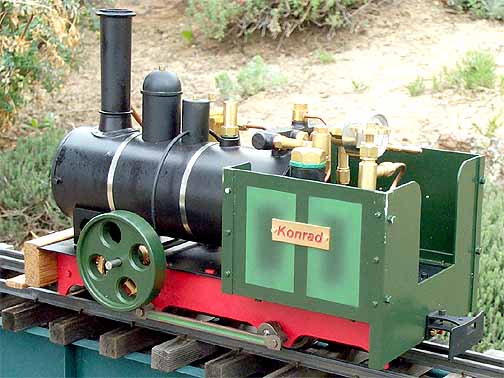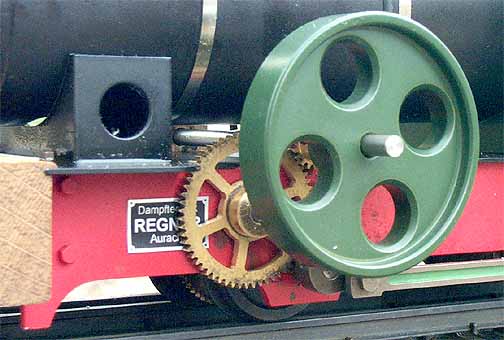by Marc Horovitz
Back to Sidestreet Bannerworks
.

Regaugeable, live-steam 0-4-0T
Regner Dampf-und Eisenbahntechnik
Erlenweg 3
91589 Aurach
Germany
Price: 480 Euros (approx $620 US) + s&h
Web site: www.regner-dampftechnik.de
Ready-to-run, entry level, live-steam locomotive; pressure gauge; safety valve; water glass; throttle; reversing lever; one, double-acting oscillating cylinder geared to axle; displacement lubricator; gas fired; engineer supplied; link-and-pin coupler on rear; all-metal construction; working pressure, 45 psi; running time, approximately 15 minutes; instructions in English. Dimensions: Length, 9-1/4"; width, 4-1/8"; height, 6-3/8". Weight: 4 lb., 8oz.
Pros: Ready to run; fully featured; charming appearance; well finished; outstanding operating characteristics; easy to run; powerful for size; excellent slow runner; well designed and fabricated; good instructions
Cons: No coupler on front

Regner, though little known in the US, is well known in Germany and other European countries, where the company has been producing steam engines of all types for 20 years or so. Regner has recently released its “Easy Line” range of beginner-oriented locomotives. Reviewed here is Konrad, a freelance, horizontal boilered, open cab, industrial-type 0-4-0 engine. The other engine in the line is Willi, similar to Konrad, but with a vertical boiler.

Konrad’s open cab makes access to all the controls very easy. There is a large gas tank on the left side. A large, ornate knob controls the gas to the burner. Steam is distributed through a manifold atop the boiler, to which is attached a throttle, a pressure gauge, and a water glass. It’s unusual for a beginner’s locomotive to have all of these desirable features. A safety valve, set at around 45 psi, sits behind the dummy sand dome.

The engine is powered by a single, double-acting oscillating cylinder, mounted vertically on the right side of the boiler. Speed is controlled by the throttle, and reversing by a small reversing lever atop the cylinder block. The steam motor drives a shaft attached to a large flywheel on the other side of the engine. This, in turn, is geared to the forward axle through a double-reduction gear, providing a 6:1 reduction. Between the throttle and the motor is a displacement lubricator disguised as an air pump. This has a filler cap, a drain plug, and a feed valve on the side.
Separate English and German instructions were provided with our review sample. These are excellent and contain color photos. The instructions include everything you'll need to know to run the engine. Also included with the locomotive is a generous bottle of steam oil; a plastic bottle for water; a fairly clunky-looking driver made, evidently, of lead; a wheel gauge; extra 0-rings, and an allen wrench.
 |
|||
| Wheels are regaugeable for gauge 1 (45mm), gauge 0 (32mm), or Regner’s own 30mm gauge. Regauging the wheels is a simple matter of loosening the set screws on the wheel hubs with the allen wrench, inserting the gauge between the wheels, moving them to coincide with the gauge, and tightening the screws. |
To get the engine going, you first fill the boiler with 102 ml of distilled water. Then you fill the lubricator with steam oil, according to the directions. Then you fill the gas tank with butane. Here I ran into a little difficulty. The gas tank fitting is larger than those commonly available in the USA and none of my adapters would fit. Regner supplies little plastic fittings with the engine that fit the gas filler, but the other end didn’t fit my adapters, either. I ended up drilling out one of the little fittings to fit my adapter, and all was well. To fill the tank, you just close the gas valve on the tank and press down on the fitting with the gas supply tank. Gas will transfer. I also had a little difficulty in determining when the tank was full.
 To light the engine, you merely crack the gas valve until you hear a hiss at the smoke stack. Then you strike a match and hold it at the stack. When I did this, the fire caught immediately, flashing back into the boiler with a low roar. Pressure was up in less than five minutes, at which time I opened the throttle. Since the engine has only one cylinder, it is not self starting. I flicked the flywheel a couple of time to clear the condensate from the cylinder, and the engine was away.
To light the engine, you merely crack the gas valve until you hear a hiss at the smoke stack. Then you strike a match and hold it at the stack. When I did this, the fire caught immediately, flashing back into the boiler with a low roar. Pressure was up in less than five minutes, at which time I opened the throttle. Since the engine has only one cylinder, it is not self starting. I flicked the flywheel a couple of time to clear the condensate from the cylinder, and the engine was away.
Its running characteristics are outstanding. Because of the large flywheel, it is an extremely smooth runner. Because of the gear reduction, the engine is both slow and powerful. It will haul eight or 10 LGB cars without complaint. A reversing lever atop the cylinder makes it easy to change direction.
The coupler provided is a link-and-pin type (you’ll have to provide your own link and pin), bit that could be easily removed and replaced with something else. Sadly, no front coupler is provided. However, one could be adapted to the wood front beam without too much difficulty.
There is an odd, somewhat inexplicable, but quite pleasant side effect that I noticed. During the run, the engine would emit loud chuffs at intermittent intervals. These sound a lot like the noises that a steam-powered water pump would make. What actually makes the noise on this engine, I don’t know. Perhaps it is condensate from the chuffer-type exhaust pipe falling back into the hot smokebox and flashing into steam. In any event, it’s nice.
The engine ran for the predicted 15 minutes, smoothly and steadily, easily maintaining pressure. When the water dropped below the bottom of the the glass, I shut the fire off (there was still gas in the tank). During the run I changed the speed and direction several times. The locomotive performed superbly. Once the cylinder is warm, all it takes is a quick flick of the flywheel to set it going again.
This is an ideal beginner’s engine. It's fun and easy to operate and, being manually controlled, you have the added enjoyment of hands-on running. It is docile, yet powerful. Its ambiguous scale makes it visually compatible with most narrow-gauge equipment (even up to 7/8" scale), and its simple construction makes it the ideal platform for some creative kitbashing. Highly recommended.